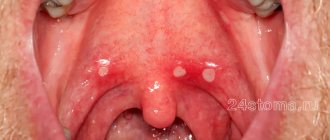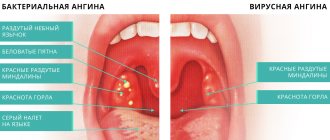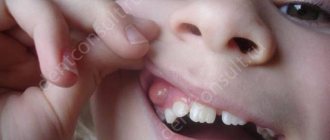Cysts in the human body are closed cavities, a kind of capsule, with contents. Their localization can be very different, but dentistry deals with the treatment and prevention of cysts located in the oral cavity. They can range in size from microscopic, in which case they are very difficult to detect with the naked eye, to impressive, which significantly complicates the quality of life of patients. The causes of cysts and methods of their treatment often depend on where exactly they formed.
Let's consider each of the options in more detail.
Types of benign tumors of the tongue
Papilloma
Focal skin growth caused by activation of the human papillomavirus in the body. The virus is transmitted when the tongue comes into contact with the mucous membrane or skin of an infected person. In the rarest cases, transmission of the virus occurs through household contact. The virus can remain dormant for a long time and appear when the immune system is weakened.
Externally, papillomas look like small pink, flesh-colored or white papillae of various shapes. Their size usually does not exceed two centimeters. You can detect these tumors yourself. They are usually localized on the back, surface and tip of the tongue. These small tumors pose a serious threat to human health because they are very often damaged and susceptible to malignancy.
Adenoma
The occurrence of this tumor is caused by the proliferation of glandular epithelium. As a rule, neoplasms are single. The following types of tongue adenoma are distinguished:
- polymorphic;
- basal cell;
- canalicular;
- sebaceous;
- adenolymphomas;
- monoform.
The pathology is usually accompanied by the formation of polyps on the tip of the tongue.
Botriomyxoma
A benign tumor of the tongue, the occurrence of which is caused by traumatic injuries - burns, cuts, injections. A couple of months after the injury, a red tumor-like formation with a lobulated or smooth surface may appear in its place. Botriomyxoma has a dense elastic consistency, sits on a stalk, and with minor damage begins to bleed.
Fibroma
A neoplasm that is formed from connective tissues covered with mucous membrane. Usually appears as small nodules, but can also look like branched polyps. The main causes of the disease are traumatic and inflammatory processes in the oral cavity. Most often, a tumor forms against the background of advanced inflammatory dental diseases - stomatitis, glossitis, periodontitis, gingivitis.
Retention cyst
The tumor occurs due to problems with the outflow of secretion from the gland, which causes blockage of the duct. Because of this, the secretion gradually accumulates in the gland, stretches it and fills it with new contents. This type of tumor is removed surgically.
Lipoma
A tumor that is predominantly localized in the back of the tongue. A lipoma forms in the submucosal layer of the tongue and has a soft and elastic consistency. Often the process of lipoma formation occurs without symptoms, so diagnosing it at an early stage is extremely difficult.
Myoma
A tumor in the tongue that occurs due to the growth of muscle tissue. Myoma has a fairly dense consistency, is covered with a mucous membrane, and small papillary outgrowths can form on it. This tumor usually reaches a centimeter in size.
Neurofibroma
A tumor develops from the sheaths of peripheral nerves. Doctors associate its formation with a defect of the facial or trigeminal nerve. This tumor is extremely rare.
Hemangioma
This is a vascular neoplasm that occurs in the tissues of blood vessels. The tumor is benign - it grows quite slowly and does not penetrate other organs. However, hemangioma is completely unpredictable, as it can suddenly increase in size and begin to interfere with the functioning of the tongue. Depending on the structure of the tumor, it can be of two types: simple (looks like a tangle of capillaries located on the mucous membrane of the tongue) and cavernous (a tangle of large vessels under the mucous membrane of the tongue).
Lymphangioma
The tumor usually grows in the walls of the lymphatic vessels, which then leads to a significant increase in the size of the tongue. Tumors often form on the tip of the tongue and its surface.
Struma of the tongue
A congenital pathology that occurs due to a violation of the location of fragments of the thyroid gland. It looks like a small organic node. After surgical removal of the tumor, the prognosis for the patient is favorable.
Salivary gland cysts
Symptoms of a salivary gland cyst
Depending on which gland it forms in, the symptoms of a salivary gland cyst can be distinguishable.
Small gland cyst
If a small gland has undergone a neoplasm, then the cyst is noticeable on the surface of the mucosa from the lower lip, and less often - on the mucosa of other parts. The small gland cyst does not exceed 1 cm in diameter and grows slowly. In appearance, it is a round elastic movable sphere protruding above the mucous membrane. It is practically imperceptible to the patient. If accidentally bitten or damaged by hard food, the cyst opens and secretes a viscous fluid, after which it closes again and mucus accumulates inside it again.
Sublingual gland cyst
Its location is under the base of the tongue. Such a cyst has a spherical or oval shape and a bluish light tint. When the cyst is located near the mylohyoid muscle, it takes on an hourglass shape.
A cyst of the sublingual gland can cause inconvenience because, as it increases in size, it provokes displacement of the frenulum of the tongue. Its incorrect position causes difficulties while eating and talking. Periodically, the cyst may spontaneously empty and be filled again with transparent or translucent secretion due to the fact that the gland continues its work.
Submandibular gland cyst
This cyst manifests itself as a fluctuating, round-shaped formation with a soft, smooth surface, located in the lower jaw, closer to the jaw joint. It can also spread to the sublingual area of the oral cavity and manifest itself as swelling of its bottom. In advanced cases, a submandibular gland cyst causes facial deformation. Like other types of similar neoplasms, this cyst can empty and fill again with liquid contents.
Parotid cyst
The parotid type of cyst, like others, has the shape of a ball with an elastic structure. A cyst forms on the mucous membrane inside the mouth near the auricle. Typically, a parotid cyst affects only one side of the mouth, which can cause facial deformity due to swelling of one cheek. The skin over the site of the cyst does not change color or structure. On palpation, the gland affected by the cyst does not show signs of fluctuation and does not cause pain.
In the absence of treatment and subsequent infection, the cyst can be complicated by abscess processes, accompanied by hyperemia of the skin and pain in the ear area. In this case, opening the mouth becomes very difficult, fluctuation and a slight increase in temperature in the tissues of the cheek are observed.
Treatment of ranula with folk remedies
With a mild course and small size of the cyst, conservative treatment is allowed. For this purpose rinses are used:
- Oak bark decoction - pour 300 g of dried bark with a glass of hot water. Leave in a water bath for half an hour, strain the resulting broth and bring with boiled water to a volume of 300 ml. Rinse your mouth 3-4 times a day; the product can be stored for up to two days.
- Lemon juice rinse – leave the juice of three lemons in the refrigerator for 48 hours. Take the remaining zest and grind it along with 33 cloves of garlic. Pour the resulting mixture with two liters of boiled water and leave it in a warm place for a day. Then strain and add lemon juice. Rinse your mouth at least five times a day.
Signs of ranula under the tongue on CT and MRI images
Selection method
- MRI.
Is an MRI of the head informative for ranula?
- Homogeneous volumetric formation with clear boundaries
- Low signal intensity on T1-weighted wall-enhanced image after gadolinium administration
- High signal intensity on T2-weighted image
- Complicated ranula appears as a hyperintense ring of fluid around the posterior border of the mylohyoid muscle on T2-weighted imaging.
- Inflammation leads to thickening of the wall.
What will CT scans of the jaw show with ranula under the tongue?
- Sublingual space-occupying formation with low density and a reinforced wall.
Features
— Simple ranula:
- Single-chamber oval formation in the sublingual space.
— Complicated ranula:
- Formation in the form of a comet's tail with a “tail” in the collapsed sublingual space and a “head” in the posterior parts of the submandibular space
- A thin ring of fluid between the mylohyoid muscle and the hyoglossus or geniohyoid muscle.
Removal of cervical lymph nodes (cervical dissection)
When removing a malignant tumor of the salivary gland, the cervical lymph nodes are usually removed, a so-called cervical dissection is performed. The lymph node is usually small, surrounded by a bean-shaped capsule, and lymph fluid flows through it. There are a large number of lymph nodes in the neck.
The first metastases of salivary gland cancer are usually found in the cervical lymph nodes and therefore it is believed that their removal is necessary in the case of cancer. Typically, surgery to remove the salivary gland, which also involves a cervical dissection, takes 1 to 2 hours longer.
Symptoms
Patients with ranula complain of a tumor-like formation in the mouth or under the chin. It does not cause pain, but sometimes there may be a feeling of tightening of the mucous membrane. The contents of the ranula are transparent and colorless. During independent palpation, patients note its density and the presence of a symptom of fluctuation - a feeling of swaying with one finger, obtained with jerky movements of the other finger. This sign allows you to establish that the cyst is filled with liquid contents. If the ranula bursts, there is a risk of secondary bacterial infection.
Ranula photo
If the cyst grows excessively, it begins to cause discomfort to patients. Infants are especially susceptible to this. An overgrown cyst can fill most of the mouth, making it difficult to eat. Against the background of a raised tongue, the act of sucking is disrupted, which subsequently leads to malnutrition and developmental delays. In adults, the chewing process suffers, and it becomes difficult to pronounce words.
Cyst removal
Sometimes, especially if the drained cyst recurs, surgical removal of the mucocele may be required. Complications from such interventions are extremely rare and include risks standard for surgical operations, such as infection and adverse reactions to local anesthesia. Be sure to consult with your dentist and surgeon to make sure you understand the risks.
If the cyst does not burst on its own, then if left untreated, a permanent lump may form in its place. Such bumps are harmless, but in general, if any tumors appear in the oral cavity, you should consult a dentist. It is important that he carefully examine the suspicious area of the oral cavity and, if necessary, conduct the necessary research, because your dental health is an integral part of the health of the whole body.
Treatment
The traditional treatment method is surgical removal of the ranula. A dentist or maxillofacial surgeon, using a scalpel under local anesthesia, first drains the ranula (releases fluid) and then removes it from the bed. This is necessary to prevent recurrence of the cyst. Sutures are placed on the edges of the wound, which dissolve after a few days. The whole procedure takes a little more than half an hour. The question of whether the ranula needs to be removed is decided individually together with the attending physician.
It makes no sense to pierce the ranula on your own and release the contents, since the cyst in such cases tends to recur. This is also dangerous because of the possibility of infection, which can subsequently lead to purulent inflammation and the formation of an abscess.
What is ranula
- 50% of patients have a history of trauma to the lower jaw or neck.
- The highest incidence is around the age of 30 years
- Ranula - retention cyst of the sublingual gland or minor salivary glands
- Usually the ranula under the tongue is acquired (post-inflammatory, post-traumatic), rarely congenital.
— Simple ranula:
- A retention cyst, lined with the epithelium of the sublingual space, occurs due to obstruction of the duct
- Corresponds to the fascial boundaries of the submandibular space.
— Complicated ranula:
- Occurs as a result of capsule rupture with spread into the submandibular space
- Pseudocyst without epithelial lining
- May spread to the anterior peripharyngeal space.









